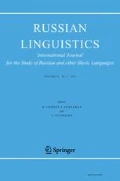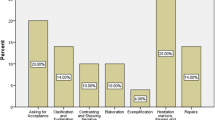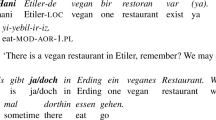Abstract
This article provides a quantitative corpus-based investigation of the Russian verb rhyme and its change in the Russian poetic tradition from the beginning of the 19th century to the 1960s. Versologists have studied the rhyme primarily as a phonetic entity, whereas morphology also contributes to the rhyme euphony due to the regularity of grammatical affixes. The research focuses on a micro-diachronic analysis of verb rhymes, summarises the identified historical trends, and defines acceptable and clearly avoided verb forms. The article also analyses the morphological patterns of verb rhymes including the most common lexical pairings and combinations of particular grammatical forms with different parts of speech. The study analyses data from the Corpus of Russian Poetry (a part of the Russian National Corpus) and introduces research methods and a corpus-based tool that were designed specifically for the statistical analysis and computational modelling of poetic features. The results show that authors experimented with word rhyme in various ways during different periods. Despite the idea of non-aesthetic verbal rhyme, which has existed since the time of A. Kantemir, its use in the historical perspective varies, there are periods of rise and fall. We distinguish two classes of rhyming pairs: combinations of two verb forms and morphologically dissimilar combinations of a verb form with a word of another part of speech. We conclude that restrictions on verbal rhyme apply mainly to combinations of past tense and infinitive forms. Nevertheless, the rhyming of indicative forms and morphologically heterogeneous rhymes is used more freely.
Аннотация
Статья представляет корпусное исследование русской глагольной рифмы и связанных с ней диахронических тенденций в русской поэтической традиции с 1800-х до 1960-х гг. До сих пор рифма исследовалась преимущественно с позиции фонетики, тогда как грамматические факторы учитывались недостаточно. Между тем морфология языка также влияет на эвфонию рифмы из-за регулярности аффиксов. Наше исследование проведено на материале Поэтического корпуса Национального корпуса русского языка. Для количественного анализа была создана база данных, содержащая дополненную разметку стиховедческих и лингвистических признаков, в том числе разметку рифмованных пар и цепочек, уточненные леммы и грамматические признаки. Результаты показывают, что авторы по-разному экспериментировали с глагольной рифмой в разные периоды. Несмотря на представление о неэстетичности глагольной рифмы, бытующее еще со времен А. Кантемира, ее употребительность в исторической перспективе носит волнообразный характер, выделяются периоды подъема и спада. Мы выделяем два класса рифмованных пар: сочетания двух глагольных форм и морфологически гетерогенные сочетания глагольной словоформы со словом другой части речи. Мы приходим к выводу, что внутри глагольной рифмы обнаруживаются ограничения в основном на сочетания форм прошедшего времени и инфинитива. Вместе с тем, рифмование индикативных форм и морфологически гетерогенные рифмы используются более свободно.




Similar content being viewed by others
Notes
Final Meeting: Selected Poetry of Anna Akhmatova. Translated by Andrey Kneller. Boston 2011.
At the moment, we have processed 60% of the verses, taking only data into account in which the rhyming schema does not change throughout the whole text.
In ipm (items per million words). Note that yet another natural way to perform normalization for the poetry data is to weight the occurrences of units per the number of verses (lines) rather than words or tokens. However, the rhymed chains can include three, four, even more than 10 rhyming lines, so weighting this data method per line would be difficult.
The absolute frequencies are weighted by the size of the corpus of a given author in a given time period.
Note that whereas A. Kantemir called the feminine infinitive rhymes like spati ‘to sleep’ as ‘vile’, by the 19th century the -ti(s’) forms were replaced by forms with the endings -t’(sja), -č’(sja), consistent with the masculine rhyme.
References
Divjak, D. S., Sharoff, S., & Erjavec, T. (2017). Slavic corpus and computational linguistics. Journal of Slavic Linguistics, 25(2), 171–198. https://doi.org/10.1353/jsl.2017.0008.
Gasparov, M. L. (2000). Očerk istorii russkogo stixa. Moskva.
Gasparov, M. L. (2005). Sovremennyj russkij stix: Metrika i ritmika. Moskva.
Gasparov, M. L., & Skulačeva, T. V. (2004). Stat’i o lingvistike stixa. Moskva.
Grišina, E. A., Korčagin, K. M., Plungjan, V. A., & Sičinava, D. V. (2009). Poetičeskij korpus v ramkax Nacional’nogo korpusa russkogo jazyka: obščaja struktura i perspektivy ispol’zovanija. In V. A. Plungjan et al. (Eds.), Nacional’nyj korpus russkogo jazyka: 2006–2008. Novye rezul’taty i perspektivy (pp. 71–113). Sankt Peterburg.
Jakobson, R. (1973). Questions de poétique. Paris.
Jarxo, B. I. (2006). Metodologija točnogo literaturovedenija. Izbrannye trudy po teorii literatury. Moskva.
Kizhner, I., Terras, M., Manovich, L., Orekhov, B., Bonch-Osmolovskaya, A., & Rumyantsev, M. (2018). The history and context of the digital humanities in Russia. In J. G. Palau & I. G. Russel (Eds.), Digital humanities 2018. Puentes-Bridges. Book of abstracts (pp. 416–419). Mexico City. Available online at https://dh2018.adho.org/abstracts/ (30 June 2020).
Kopotev, M., Lyashevskaya, O., & Mustajoki, A. (2018). Quantitative approaches to the Russian Language. London, New York.
Kuzmenko, E., & Orekhov, B. (2016). Geography of Russian poetry: Countries and cities inside the poetic world. Digital Humanities 2016: Conference Abstracts. Jagiellonian University & Pedagogical University, Kraków (pp. 830–832). Kraków.
Ljaševskaja, O., & Šarov, S. (2009). Častotnyj slovar’ sovremennogo russkogo jazyka (na materialax Nacional’nogo korpusa russkogo jazyka). Moskva.
Orexov, B. V. (2015). Ešče raz ob issledovatel’skom potenciale poetičeskogo korpusa: metr, leksika, formula. Trudy instituta russkogo jazyka imeni V. V. Vinogradova, 6, 449–463.
Samojlov, D. (2005). Kniga o russkoj rifme. Moskva.
Scherr, B. P., Bailey, J., & Kazartsev, E. V. (Eds.) (2011). Formal methods in poetics. A collection of scholarly works dedicated to the memory of Professor M. A. Krasnoperova. Lüdenscheid.
Semenov, V. B. (2009). Statističeskie metody v russkom stixovedenii XX veka: Andrej Belyj i A. N. Komogorov. Vestnik Moskovskogo universiteta. Serija 9: Filologija, No. 6, pp. 36–44.
Taranovskij, K. (2010). Russkie dvuxsložnye razmery. Stat’i o stixe. Moskva.
Tomaševskij, B. V. (1959). Stix i jazyk. Moskva, Leningrad.
Wachtel, M. (2004). The Cambridge introduction to Russian poetry. Cambridge.
Žirmunskij, V. (1923). Rifma, ee istorija i teorija. Petrograd.
Author information
Authors and Affiliations
Corresponding author
Additional information
Publisher’s Note
Springer Nature remains neutral with regard to jurisdictional claims in published maps and institutional affiliations.
The research was prepared within the framework of the Academic Fund Program at the National Research University Higher School of Economics (HSE) in 2018–2019 (grant #18-05-0047) and by the Russian Academic Excellence Project «5-100».
Rights and permissions
About this article
Cite this article
Lyashevskaya, O., Litvintseva, K., Vlasova, E. et al. Verb rhyme in Russian poetry: a quantitative analysis. Russ Linguist 44, 145–156 (2020). https://doi.org/10.1007/s11185-020-09227-w
Published:
Issue Date:
DOI: https://doi.org/10.1007/s11185-020-09227-w




